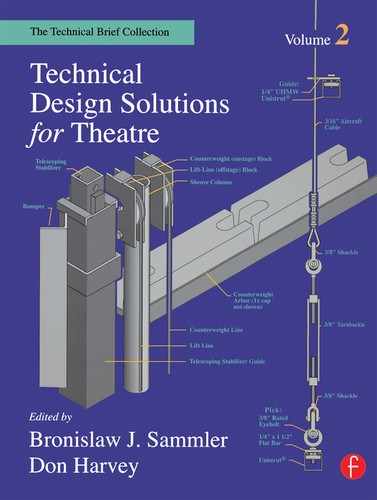Rotating Doors |
Jim Kempf |
The design for LA Shakespeare Festival’s traveling production of Turning of the Shrew included a row of ten rotating doors. One side of each door was paneled for use in exterior scenes: the other side was painted to form part of a 30′ long mural for interiors. Each of the doors needed to spin individually for actor entrances, but at seven moments during the show, all ten doors had to be quickly linked so that an unseen operator could open them simultaneously. The director described this movement as similar to the starting gates at a horse race. The action of the play left plenty of time to link the doors, but the release time had to be kept under five seconds. In two scenes, actors rushed through pairs of doors almost immediately after the entire row had turned.

FIGURE 1: ROTATING DOORS — OVERVIEW
Several factors influenced the design of the rig. First, the doors had to rotate through 90°, 180°. and 360°. Second, since the production was to play at four different venues, the mechanics had to assemble quickly and easily, and the rig had to be sturdy, dependable, and simple. With the show performing as far as 60 miles away from the shop, even basic repairs would prove extremely challenging. Finally, the height of the balcony under which the rig would be mounted could not be determined until load-in at the first venue. Thus, the rig’s height had to be made adjustable to fit a range of possibilities.

FIGURE 2: DOOR HARDWARE DETAILS
Figure 2 shows the doors’ hardware. Each door spun freely on a ¾″ shaft in a deckmounted flange block. At the top of each door, short sleeves of 1″ schedule 40 black pipe welded to a 31′ long beam of 1″ box tube stabilized the doors’ upper shafts and guaranteed their exact spacing. Above the stabilizing beam, long sleeves of 1″ schedule 40 black pipe held the 20″ upper shafts in place. A 6″ sheave was mounted on each door shaft and a 10″ sheave was mounted to the tensioning hardware offstage. A nicopressed drive loop of ⅛″ aircraft cable was wrapped once around each 6″ sheave and, to augment friction, twice around the 10″ sheave.
Figure 3 shows the tensioner: a short piece of 2½″ box tube sliding on a longer piece of 2″ box tube welded to the end of the 1′ beam. The 10″ sheave itself was mounted on a ¾″ shaft held in a sleeve of 1′ schedule 40 black pipe that was welded to the 2½″ box tube. One short “clip” made of 2″ angle iron was welded to the 2½″ box tube: another, to the 2″ box tube. A ½″ bolt welded to the angle iron on the 2½″ box tube passed through holes in clips and was nutted at the offstage end. Tightening or loosening the nut with a speed wrench quickly adjusted the cable tension by moving the carriage. When slack, the cable would slip on the sheaves and the doors could spin independently. When tensioned, the cable caused all the doors to open or close simultaneously in response to movement of the operating arm. It took only about seven turns of the wrench to tension or slack the cable sufficiently. Since the audience was 30′ away, they did not notice that the operator walked behind the doors and dressed them into alignment before linking them.
The rig held up well during performances and transport, and its operation required only one crew member’s part-time attention. The motion of the cable running on itself caused an audible “swoosh,” but the director was actually pleased by both the spectacle and the sound it made.

